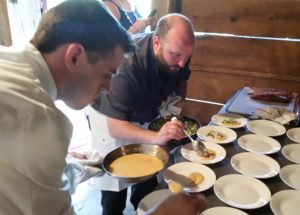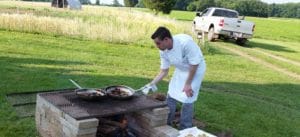Gastronomic Tourism: Are you Cashing In?
Local farmers are cashing in on Gastronomic Tourism in a big way, but with one-third of all tourism spending floating around waiting to be captured, the market hardly seems saturated.
Food-based tourism is more popular than ever. Exemplified by TV shows like Anthony Bourdain’s No Reservations and Parts Unknown, celebrity chefs are taking to the tourism circuit around the globe. Great Britain’s Alan Coxon, a multi-award winning chef and TV show host, named the ambassador of food this month, will be promoting Great Britain’s food, beverage and tourism industry as a whole.

Chefs Sam Strock (left) and Josh Fidler (right) prepare small plates to begin the Rettland Farm Supper Club event.
Known by many names, Gastronomic Tourism is a measured food trend across the globe. Once focused solely on the wine industry, food-based tourism, that is travel planning focused on educational, cultural or experiential activities surrounding the local food of each visited region, is now a significant trend in the local food sector.
According to Quan and Wang, 2004, when data was just beginning to be gathered, over one-third of all travel dollars were devoted to food purchases. For many travelers culinary based tourism extends much further from the plate. It includes attendance at local food festivals, tours of local farms, a visit to the farmers’ market and private dining experiences at many of these locations. According to 2012 data, eating-related activities are the second most favorite activity of all tourists visiting the U.S. This translates into a substantial opportunity for agri-tourism farms as well as those selling directly to the public or local foods based restaurants.
Local farmers are cashing in on this trend in a big way, but with one-third of all tourism spending floating around waiting to be captured, the market hardly seems saturated. If you happen to be located near an established tourism
epicenter, like Gettysburg, PA, transitioning to this trend is easy. One small, diversified family farm offered their first on-farm supper in June. Rettland Farms paired up local Chef Josh Fidler, his 154 Supper Club and Chef Sam Strock to offer a night under the stars. Seats were opened first to their Community Supported Agriculture members, those who are already local supporters of the farm, and then to visitors at large. Participants to this exclusive dinner were treated to a tasting menu of 6 local food dishes to fill their bellies and provide ample conversational topics for an educational and fun evening on the farm – the makings of a perfect tourism experience.
In New York, already a famed destination for wine-focused tourism, growers are taking advantage of the new hard cider trend. Cider Week, an event brand that has spread across the country celebrates what they deem “America’s oldest libation.” With events from New York to Washington in the months of October and November 2014, this tourist-marketed experience offers full day celebrations gathering apple growers and hard cider makers from each region to celebrate this hip, ultra-local trend. Events offer demonstrations, tastings, local food pairings and socializing space for foodie tourists and locals alike.

Chef Sam Strock prepares menu items over open fire at Rettland Farm.
For agricultural producers, marketing to capture tourism dollars may be easier than you think. Simple changes such as telling your customers where you grow and how you sell your products may make all the difference. Producers have noticed an upswing in restaurant sales after talking to shoppers at their farmers’ market stands about which restaurants buy their products. This enables the foodie driven shopper to not only visit your stand while they take in the scene at the farmers’ market but to get pointed to a restaurant to visit while in town. When it comes to tourism, word of mouth says it all. Be sure to encourage customers that buy directly from you as well as businesses that purchase your product to promote their use of your local products on websites like Trip Advisor and Yelp. One local food comment can go a long way to entice the right food-focused tourist.
Carla Snyder is the Agricultural Entrepreneurship and Marketing Educator with Penn State Extension in Gettysburg, PA. She can be reached at 717-334-6271 or by email at snyder.carla@psu.edu.



Don’t forget school and student tourism related to the farm to school programs and school gardens. Think of the positive growing impact and the wonders of children seeing a carrot pulled from the earth for the first time, or finding an egg in a nest box. These small, let’s call it ‘educational student tourism’ programs, such as a two hour visit to a farm can make a lifetime of difference to child’s view of agriculture and food sources. These visits, whether to a farm or a farmer visiting them, enriches their lives and earns respect for the farmers. The ‘profit’ is more than monetary. The farmer can help develop agriculture as a understood and well respected profession. We are grateful for the Small Farms Program and your inspiration.
Gastronomic Tourism truly seems to be an untapped market connecting local farmers with food enthusiasts. The blend of educational experiences and local flavors creates a compelling draw for both tourists and the farming community.
Expert Welding Services in Riverside CA